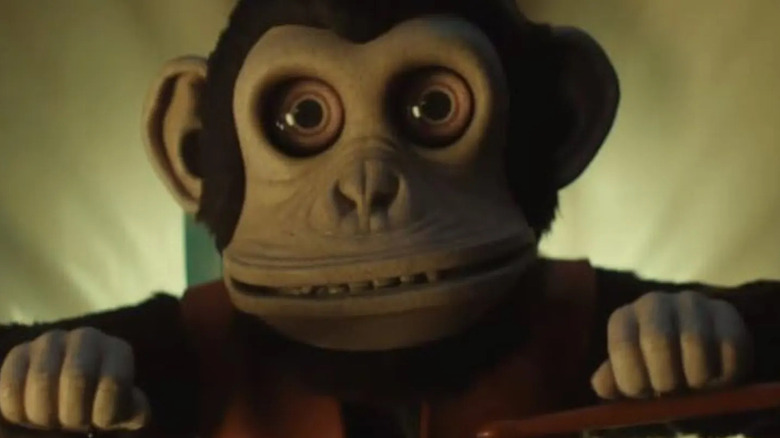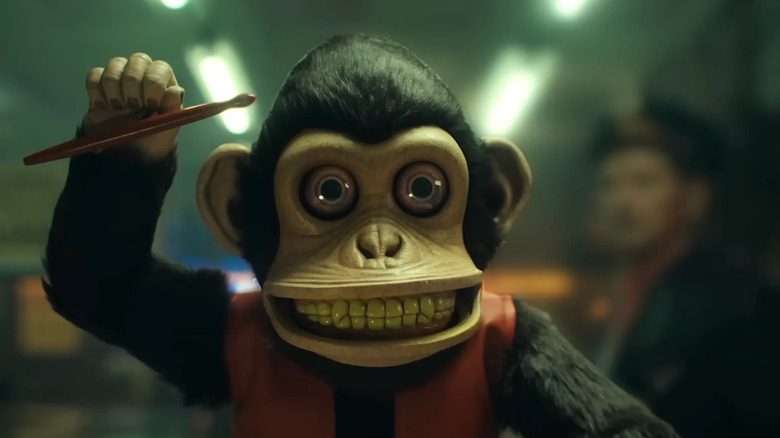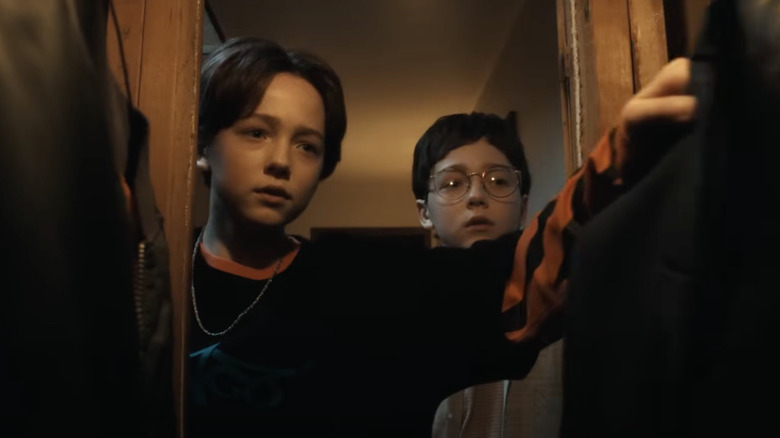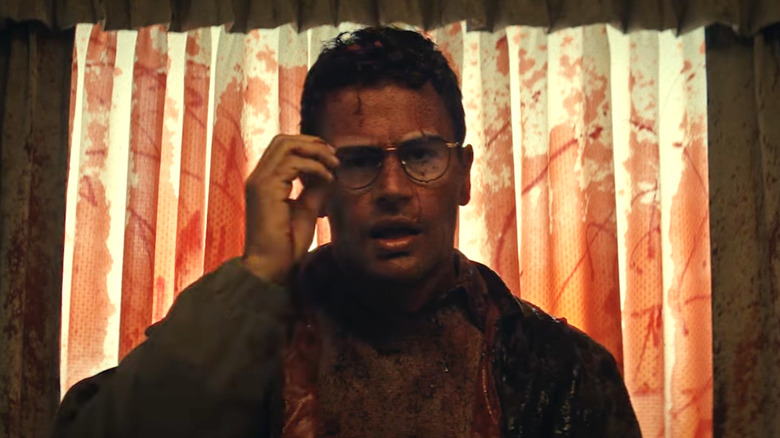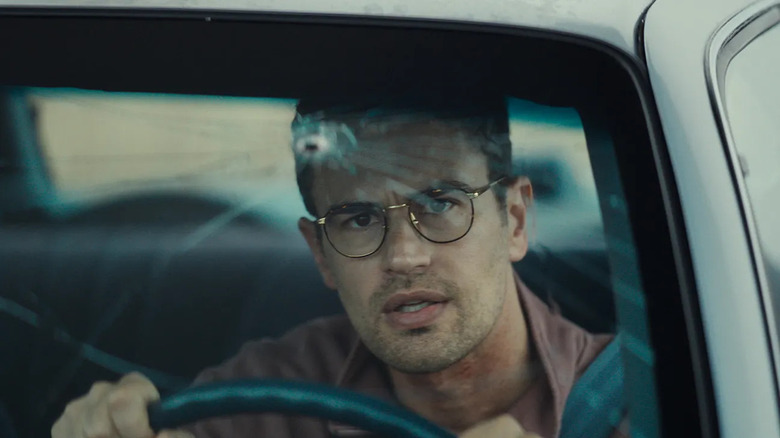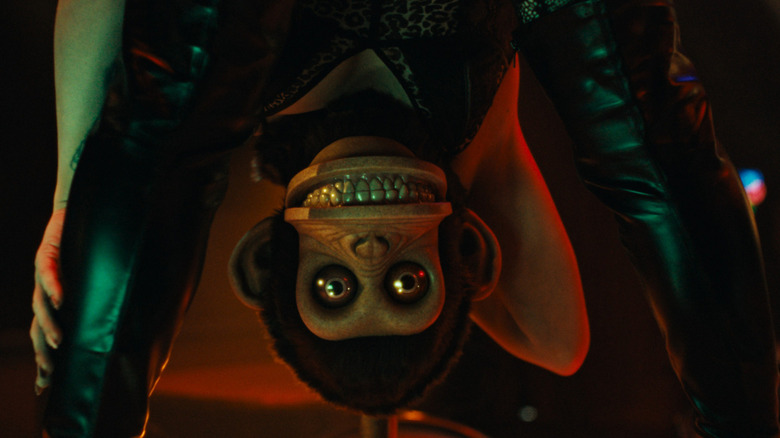Every Big Change The Monkey Makes To The Classic Stephen King Short Story
Spoilers for "The Monkey" follow.
"Longlegs" director Osgood Perkins is back with "The Monkey" (you can read our review of the film right here), a blood-soaked horror-comedy based on a short story by the king of horror himself, Stephen King. King is one of our most prolific writers, and a huge chunk of his bibliography has been adapted to the screen. Some of these adaptations, like 1989's "Pet Sematary," which has a screenplay by King himself, remain fairly true to the source material. Then you have takes that veer off into their own directions. King has gone on record as saying he's not particularly upset when film adaptations of his work change things up, telling Vulture: "My idea is, 'If you're going to make changes, hopefully they'll work.'" At the same time, King isn't shy about voicing his displeasure when he feels changes don't work. After all, he's spent decades telling everyone and anyone who will listen how annoyed he is about Stanley Kubrick's adaptation of "The Shining," which alters the source material in some big ways.
When it comes to "The Monkey," Perkins, who also penned the script, has plenty of wiggle room: King's work is a short story (first published in 1980 and later collected in King's 1985 anthology book "Skeleton Crew"), which means the filmmaker needed to beef up the material a bit to make a full-length movie. And it looks like King himself is fine with those changes: he recently shared his (positive) thoughts on the film on social media. Perkins actually stays somewhat faithful to the story, at least in the first half-hour or so of the film. Then "The Monkey" starts changing things up in some pretty big ways.
The Monkey toy is different in the movie ... because of Disney
One of the biggest difference between the story and the film is the look of the monkey itself. While King doesn't fully describe the size of the doll, the implication is that it's not very big. In the film, however, the monkey is surprisingly large. But that's not the only difference. In King's story, the monkey, which is based on real wind-up monkeys that used to be sold as novelties, holds a pair of tiny cymbals. Winding up the key on the monkey's back causes the clockwork toy to bang its cymbals together, which, in effect, sets off a chain of events that will lead to someone's death.
In Perkins' film, however, the monkey doesn't have cymbals. Instead, it has a drum that it beats with a pair of drumsticks. And there's a surprising reason for this change. According to Perkins, producers told him he had to change the monkey design because Disney currently owns the copyright to the monkey with cymbals. Apparently, the House of Mouse snatched up these rights to use a wind-up monkey with cymbals in "Toy Story 3." All things considered, I actually think this worked in the movie's favor: the monkey banging on its drum makes for a more ominous image than clanging some cymbals together.
The Monkey short story serves as a starting point for the movie
As stated above, the first half-hour (give or take) of "The Monkey" remains pretty true to King's story. In that story, a man named Hal Shelburn is cleaning out a dead relative's house with the help of his wife and two sons. While digging through piles of junk, Hal's kids find a wind-up toy monkey. Hal is horrified to see the doll, and for good reason — it has the power to kill! To be clear: this isn't a Chucky situation, where the doll runs around bumping people off. Instead, there's some sort of dark supernatural power radiating from the monkey that results in various random deaths.
In the story, we learn that the monkey was first acquired by Hal's father, a Merchant Marine who vanished when Hal was a kid. This is King pulling from his own history: when he was young, his own father, also a Merchant Marine, abandoned the family. Like King, Hal never learns what really happened to his dad — but he suspects the evil monkey had something to do with it. Perkins' film changes things up slightly here: we're treated to a prologue with Hal's father, played by Adam Scott in a surprise cameo, trying to get rid of the monkey by giving it back to the pawn shop where he acquired it. (Also: the father's occupation has been changed from a Merchant Marine to an airline pilot). The monkey ends up causing the death of the pawn shop owner, and Scott's character then tries to destroy the toy with a flamethrower that (amusingly) happens to be lying around. After this, we never see Scott's character again and never learn what happened to him. After this, young Hal and his twin brother Bill (both played by Christian Convery) inexplicably find the monkey in a closet. The boys soon make the horrifying discovery that whenever someone winds up the key on the monkey's back, someone else will die (the only "rule" seems to be that the monkey never kills the person who wound it up).
This is somewhat true to the story, which is mostly told via flashbacks. In the story, the adult Hal remembers the monkey causes several deaths when he was a child, including the death of Hal's babysitter and his own mother. Perkins keeps these details in the film, but alters them here and there. For instance: Hal's babysitter in the story is named Beulah, which is also the name of a real babysitter Stephen King had as a child. The story reveals that shortly after Hal wound up the monkey, Beulah was killed by her boyfriend, who shot her during an argument. In the film, however, the babysitter has been renamed Annie Wilkes (played by Danica Dreyer). King fans will recognize that name: it's the name of the psychotic fan from King's novel "Misery," played so memorably by Oscar-winner Kathy Bates in the "Misery" movie. Annie's death in "The Monkey" movie is far more colorful than a shooting: her head is accidentally cut off by a hibachi chef.
In the story, young Hal, realizing the monkey is evil and killing people (and pets), chucks the damn thing into a well and hopes to never see it again. But sure enough, the monkey resurfaces when Hal is an adult. As the story draws to an end, Hal attempts to rid himself of the monkey once and for all by sinking it in a lake with the help of his youngest son, Petey. In an epilogue, it's revealed that all the fish within the lake have mysteriously died. None of this happens in the movie, though. Instead, Perkins mostly uses the flashback details of Hal as a child during the first half-hour of the film ... and then changes the story considerably once Hal is an adult.
Hal and Bill are not twins with a deadly rivalry in the story
After using the initial set-up from King's story to get things going, Perkins' "The Monkey" then starts making some pretty big changes. While Hal does have a brother named Bill in the story, the two of them are not identical twins. On top of that, Bill is a very minor character who doesn't do much. For the film, however, Hal and Bill, both played by Theo James as an adult, have an adversarial relationship, and Bill is a major character. Bill correctly guesses that the death of their mother Lois (Tatiana Maslany) was caused by Hal winding up the killer monkey, and therefore blames Hal for their mother's death (Hal was actually winding the monkey up because he hoped it would kill Bill, but unfortunately, the monkey doesn't take requests).
In the film, the adult Hal and Bill are estranged, and we learn that Bill has spent most of his life trying to find the monkey after it vanished when the twins dropped it down as a well when they were still children. Bill's plan is to wind the monkey up and hope it kills Hal, which, honestly, isn't much of a plan at all. Eventually, the monkey does turn up at a yard sale, where it's purchased by Ricky ("Halloween Ends" star Rohan Campbell), who eventually sells the monkey to Bill. However, Ricky decides he wants the monkey back because (for some reason) it reminds him of his father, who, just like Hal and Bill's father, disappeared when he was a kid.
With the monkey back in his hands, Bill starts winding it up over and over again. Instead of killing Hal, though, the monkey causes the (gory) deaths of various other people via "Final Destination"-like ways. The body count piles up pretty quickly. None of this is in the story.
Story Hal and movie Hal are much different characters
While Hal is the main character of both the story and the movie, many details differ. In the film, Hal has deliberately cut himself off from the world out of fear — after watching the monkey kill various people during his childhood, including his mother, he fears getting too close to anyone because he knows they'll eventually die. Because of this, Hal is divorced from his wife (Laura Mennell) and estranged from his teenage son Petey (Colin O'Brien).
In the story, however, Hal is still married and actually has two sons: the surly teenager Dennis, who appears to have a drug problem, and the much younger Petey. Hal and his wife Terry also fight a lot, and Terry also seems to have a drug problem: she keeps popping pills and taking long naps. Hal grows surly and downright violent when the cursed monkey toy resurfaces, and finds himself constantly bickering with his family. It's all rather unpleasant and kind of miserable. Which brings us to perhaps the biggest difference between the story and the movie.
The Monkey movie is intentionally funny, the story is not
Osgood Perkins has a great (dark) sense of humor. I'm of the opinion that his horror hit "Longlegs" is actually quite funny, and I don't mean in an ironic, unintentional way — I genuinely believe Perkins was trying to make audiences laugh with many of the film's scenes. With "The Monkey," Perkins goes all-in on humor: this is not a horror movie, it's a horror-comedy. Perkins is also clearly working through some issues here: both of his parents died in shocking ways. His father, actor Anthony Perkins, died from AIDS-related pneumonia, while his mother, actress and photographer Berry Berenson, was killed in the 9/11 attacks (she was on American Airlines Flight 11, which was crashed into the North Tower of the World Trade Center). Perkins likely (and understandably) has a complicated relationship with death, and his adaptation of "The Monkey" is very much about how darkly absurd it is that no matter what we do, we're all going to die some day.
When Perkins came on board to direct "The Monkey," the project had a completely different script that was, according to the filmmaker, "very serious." Indeed, Perkins told the producers that the script was too serious for him. Instead, he wanted to go down a more comedic path. "The thing with this toy monkey is that the people around it all die in insane ways," Perkins said. "So, I thought: 'Well, I'm an expert on that. Both my parents died in insane, headline-making ways.'" And to be sure, a story about a toy monkey that kills people does sound rather silly.
And yet ... King's story isn't funny at all. Instead, it's, dare I say, actually scary. It's a testament to King's gifts as a storyteller that he manages to make his "killer toy monkey" story genuinely creepy. The author has a knack for building suspense and horror, and there's a genuine sense of dread built into the short tale from the jump. I like Perkins' film adaptation and think it's amusing in all the right ways, but I think I like the story more just because King pulls off the impossible and manages to turn a goofy premise into something legitimately creepy.
